INTERNATIONAL POLAR BEAR DAY
A Strive for Artic Conservation
By Alyssa Jairam
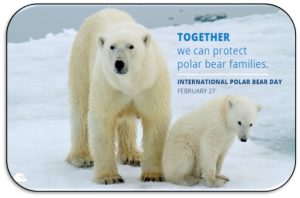
“To survive today, some animals must endure climate change, pollution and fewer habitats.
More tragically, they must endure the silence of human hearts.
Together, we can ensure their future.”
1.0. Observing International Polar Bear Day and Its Purpose:
International Polar Bear Day is observed annually on 27th February and serves as a heart-breaking reminder of the various challenges that inhabitants of the Artic region face and their fight for survival. This day is dedicated to raising awareness about the plight of polar bears and the urgent need for conservation efforts to protect their fragile habitat. At present, as climate change accelerates, the Arctic is undergoing unprecedented transformations, and the survival of our polar bears is being jeopardized. In this feature, we explore the significance of International Polar Bear Day and the pressing issues surrounding polar bear conservation.
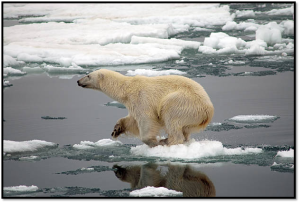
2.0 Facts About Polar Bears:
Polar bears (Ursus maritimus) are the largest of the extant (still surviving) bear species and are classified as marine mammals. They reside in the Artic and nearby areas and since polar bears are closely related to brown bears, both species can interbreed. Since polar bears are largely dependent on sea ice, their native range lies throughout the circumpolar Arctic, primarily above the Arctic Circle which is one of the largest ranges for an extant large carnivore. Polar bears occur in 19 sub-populations throughout the seasonally and permanently ice-covered marine waters of the Arctic and Sub-Arctic regions of Canada, Greenland, Norway, Russia and the United States (U.S. Fish and Wildlife Service, 2024).
As of 2024, the global polar bear population is approximately 26,000 individuals (Polar Bear International, 2024). Male polar bears have an average height of 8-10 feet and weigh between 550-1700 pounds. Females, however, are generally 6-8 feet tall and weight between 330-650 pounds (PBS, 2024). Polar bears prey heavily on Ringed Seals and their fur, which appears white, is actually translucent but appears white since it reflects visible light and allows them to camouflage against the ice by blending into the environment and sneaking-up on their prey. The thick layer of fur also helps to insulate them from the cold (Byjus, 2024). However, beneath their white fur, polar bears actually have black skin (WWF, 2024). Polar bears also have a very strong sense of smell as they can smell their prey from almost one kilometer away. While polar bears typically roam at a speed of about 5.5km/h (3.4mph), they run (sprint) at an estimated speed of up to 40km/h (25mph). Additionally, polar bears are great swimmers as they can reach speeds up to 10km/h (6.2mph) in water and can swim steadily for many hours (and in some cases days) to get from one piece of ice to another. This is because their paws are adapted for swimming which they use to paddle through the water while holding their hind legs flat (WWF, 2024).
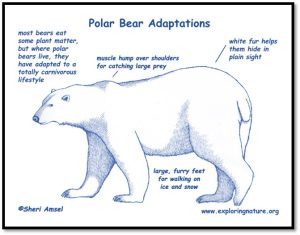
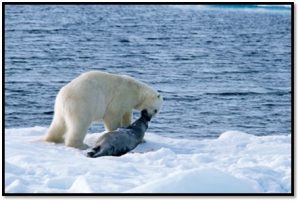
3.0 Understanding the Polar Bear’s Plight:
Female polar bears generally mature and breed for the first time at 4-5 years old and give birth at around 5-6 years of age. The litter size typically ranges between 1-3 cubs which remain with their mother until they are 2 years old. (FWS, 2024). Since polar bears are uniquely adapted to life in the Arctic and rely on sea ice as a platform for hunting and gathering food, climate change has resulted in the rapid decline of the Arctic sea ice which is directly impacting the abilities of polar bears to hunt, breed and survive. As sea ice diminishes, polar bears are facing longer and more perilous journeys in search of food which is also leading to increased competition, malnutrition and lower reproduction rates. Between 2001-2010, a 40 percent polar bear population loss was documented in NE Alaska and NW territories (WWF, 2024). This statistic therefore shows the urgency required for the protection and survival of our polar bears to avoid extinction.

4.0 Threats to Polar Bears:
Some key threats to the polar bear population include:
- Climate Change: The primary threat to polar bears is the loss of their sea ice habitat due to climate change. Rising global temperatures lead to the melting of polar ice which is reducing the bears’ access to vital hunting grounds and forcing them to travel longer distances in search of food.
- Pollution: In particular, the accumulation of toxins in the Arctic environment poses a threat to polar bears. These contaminants enter the food chain and can affect the health of bears, leading to reproductive issues and weakened immune systems.
- Oil and Gas Development: The expansion of oil and gas exploration in the Arctic increases the risk of oil spills which can have catastrophic consequences for polar bears and their environment. Oil spills can contaminate their habitat, coat their fur and harm their prey.
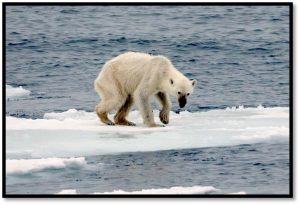
5.0 Conservation Efforts:
International Polar Bear Day serves as a catalyst for global action to protect these magnificent creatures and their fragile ecosystem. Some conservation initiatives include:
- Climate Change Mitigation: Advocating for and implementing measures to mitigate climate change is crucial for preserving polar bear habitats. This includes: reducing greenhouse gas emissions and supporting renewable energy initiatives.
- Conservation Research: Continued research on polar bear behavior, population dynamics and health are essential for informed conservation strategies. Understanding the bears’ needs and challenges is vital for effective protection.
- International Cooperation: Collaborative efforts between nations, indigenous communities and environmental organizations are necessary to address the complex challenges facing polar bears. For instance, shared responsibility and coordinated actions can lead to more effective conservation outcomes.
- Education and Awareness: Raising public awareness about the plight of polar bears and the impacts of climate change is critical. International Polar Bear Day provides an opportunity to engage communities, schools and individuals in conversations about conservation.
6.0 Conclusion:
As we observe International Polar Bear Day, it is crucial to recognize the urgency of addressing climate change and its impacts on the Arctic ecosystem. By supporting conservation efforts, advocating for sustainable practices and fostering global cooperation, we can strive to ensure a future where polar bears and cubs thrive in their natural habitat. Together, we can make a difference and secure a more sustainable and resilient Arctic environment for generations to come as living on the Artic is a harsh place to survive.
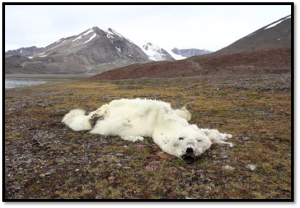
Don’t Let Polar Bear Deaths Continue!
References
- “Are Polar Bears Endangered?” 2024. Retrieved from Polar BearsInternational.org: https://polarbearsinternational.org/polar-bears-changing-arctic/polar-bear-facts/status/
- “International Polar Bear Day.” 2024. Retrieved from PolarBearsInternational.org: https://polarbearsinternational.org/act-now/awareness-events/international-polar-bear-day/
- “Polar Bear Fact Sheet.” 2020. Retrieved from Public Broadcasting Service (PBS): https://www.pbs.org/wnet/nature/blog/polar-bear-fact-sheet/#
- “Polar Bear Overview.” 2024. Retrieved from U.S. Fish and Wildlife Service: https://www.fws.gov/species/polar-bear-ursus-maritimus
- “Top 10 Facts About Polar Bears.” 2024. Retrieved from WWF.org: https://www.wwf.org.uk/learn/fascinating-facts/polar-bears
- “Why Do Polar Bears Have White Fur?” 2024. Retrieved from BYJUS.com: https://byjus.com/question-answer/why-do-polar-bears-have-white-fur-coloured-fur-on-the-body-very-small-size-1/
